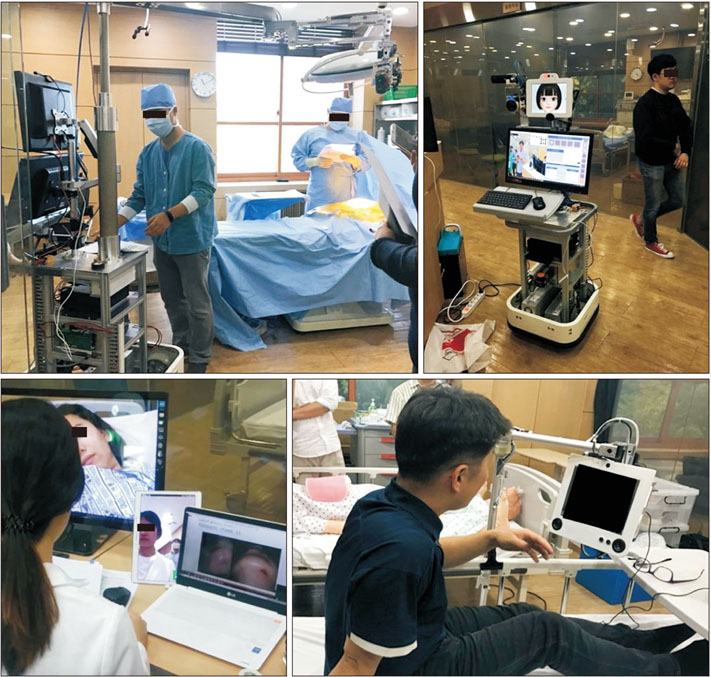Healthc Inform Res.
2018 Jan;24(1):12-21. 10.4258/hir.2018.24.1.12.
Scenario-Based Assessment of User Needs for Point-of-Care Robots
- Affiliations
-
- 1College of Nursing, Seoul National University, Seoul, Korea. jeoungeunkim0424@gmail.com
- 2Research Institute of Nursing Science, Seoul National University, Seoul, Korea.
- KMID: 2403291
- DOI: http://doi.org/10.4258/hir.2018.24.1.12
Abstract
OBJECTIVES
This study aimed to derive specific user requirements and barriers in a real medical environment to define the essential elements and functions of two types of point-of-care (POC) robot: a telepresence robot as a tool for teleconsultation, and a bedside robot to provide emotional care for patients.
METHODS
An analysis of user requirements was conducted; user needs were gathered and identified, and detailed, realistic scenarios were created. The prototype robots were demonstrated in physical environments for envisioning and evaluation. In all, three nurses and three clinicians participated as evaluators to observe the demonstrations and evaluate the robot systems. The evaluators were given a brief explanation of each scene and the robots' functionality. Four major functions of the teleconsultation robot were defined and tested in the demonstration. In addition, four major functions of the bedside robot were evaluated.
RESULTS
Among the desired functions for a teleconsultation robot, medical information delivery and communication had high priority. For a bedside robot, patient support, patient monitoring, and healthcare provider support were the desired functions. The evaluators reported that the teleconsultation robot can increase support from and access to specialists and resources. They mentioned that the bedside robot can improve the quality of hospital life. Problems identified in the demonstration were those of space conflict, communication errors, and safety issues.
CONCLUSIONS
Incorporating this technology into healthcare services will enhance communication and teamwork skills across distances and thereby facilitate teamwork. However, repeated tests will be needed to evaluate and ensure improved performance.
MeSH Terms
Figure
Cited by 1 articles
-
Review of Smart Hospital Services in Real Healthcare Environments
Hyuktae Kwon, Sunhee An, Ho-Young Lee, Won Chul Cha, Sungwan Kim, Minwoo Cho, Hyoun-Joong Kong
Healthc Inform Res. 2022;28(1):3-15. doi: 10.4258/hir.2022.28.1.3.
Reference
-
1. Nickelson DW. Telehealth and the evolving health care system: strategic opportunities for professional psychology. Prof Psychol Res Pr. 1998; 29(6):527–535.
Article2. Latifi R, Gunn JK, Bakiu E, Boci A, Dasho E, Olldashi F, et al. Access to specialized care through telemedicine in limited-resource country: initial 1,065 teleconsultations in Albania. Telemed J E Health. 2016; 22(12):1024–1031.
Article3. Kang HJ. Policy direction for decreasing the concentration of patients to extra-large hospitals. Health Welf Policy Forum. 2014; 210:65–76.4. Kim KW, Kim SH, Park KN, Kim HJ, Oh SH, Lee JY, et al. Mid-term effects of tertiary hospital beds expansion on emergency department overcrowding. J Korean Soc Emerg Med. 2014; 25(6):722–729.5. Backhaus A, Agha Z, Maglione ML, Repp A, Ross B, Zuest D, et al. Videoconferencing psychotherapy: a systematic review. Psychol Serv. 2012; 9(2):111–131.
Article6. Barros RS, Borst J, Kleynenberg S, Badr C, Ganji RR, de Bliek H, et al. Remote collaboration, decision support, and on-demand medical image analysis for acute stroke care. In : Dustdar S, Leymann F, Villari M, editors. Service-oriented and cloud computing. Cham, Switzerland: Springer;2015. p. 214–225.7. Dharmar M, Romano PS, Kuppermann N, Nesbitt TS, Cole SL, Andrada ER, et al. Impact of critical care telemedicine consultations on children in rural emergency departments. Crit Care Med. 2013; 41(10):2388–2395.
Article8. Gardiner S, Hartzell TL. Telemedicine and plastic surgery: a review of its applications, limitations and legal pitfalls. J Plast Reconstr Aesthet Surg. 2012; 65(3):e47–e53.
Article9. Wang TT, Li JM, Zhu CR, Hong Z, An DM, Yang HY, et al. Assessment of utilization and cost-effectiveness of telemedicine program in western regions of China: a 12-year study of 249 hospitals across 112 cities. Telemed J E Health. 2016; 22(11):909–920.
Article10. Moffatt JJ, Eley DS. The reported benefits of telehealth for rural Australians. Aust Health Rev. 2010; 34(3):276–281.
Article11. Ray RA, Fried O, Lindsay D. Palliative care professional education via video conference builds confidence to deliver palliative care in rural and remote locations. BMC Health Serv Res. 2014; 14(1):272–279.
Article12. Ebell M. Information at the point of care: answering clinical questions. J Am Board Fam Pract. 1999; 12(3):225–235.
Article13. Svanaes D, Alsos OA, Dahl Y. Usability testing of mobile ICT for clinical settings: methodological and practical challenges. Int J Med Inform. 2010; 79(4):e24–e34.14. Beer JM, Prakash A, Mitzner TL, Rogers WA. Understanding robot acceptance. Atlanta (GA): Georgia Institute of Technology;2011.15. Broadbent E, Stafford R, MacDonald B. Acceptance of healthcare robots for the older population: review and future directions. Int J Soc Robot. 2009; 1(4):319–330.
Article16. Maguire M, Bevan N. User requirements analysis: a review of supporting methods. In : Proceedings of IFIP 17th World Computer Congress; 2002 Aug 25-30; Montreal, Canada. p. 133–148.17. Kim KJ, Park E, Sundar SS. Caregiving role in human-robot interaction: a study of the mediating effects of perceived benefit and social presence. Comput Human Behav. 2013; 29(4):1799–1806.
Article
- Full Text Links
- Actions
-
Cited
- CITED
-
- Close
- Share
- Similar articles
-
- User perception of medical service robots in hospital wards: a cross-sectional study
- Clinical Use of Robots as a Part of Rehabilitation Medicine
- Role of computers and robots in future otological surgery
- Evaluation of Algorithm-Based Simulation Scenario for Emergency Measures with High-Risk Newborns Presenting with Apnea
- Virtual reality based stroke rehabilitation


